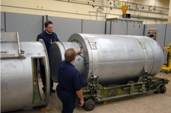
Meeting U.S. Nuclear Nonproliferation Treaty Commitments
NNSA maintains the U.S. nuclear weapons stockpile and, because of this nuclear weapons expertise, helps to prevent the spread of nuclear weapons and material around the world. President Bush has asked for the lowest possible number of nuclear weapons consistent with U.S. national security needs, and so NNSA is helping to dramatically reducing its nuclear arsenal. President Bush has asked for the lowest possible number of nuclear weapons consistent with U.S. national security needs, and so NNSA is helping to dramatically reducing its nuclear arsenal.
In 2002, President Bush signed the Moscow Treaty with the Russian Federation, which set a goal of reducing deployed nuclear weapons to between 1700-2200 by 2012, a dramatic decrease from the past. The United States has already decreased by about half the number of deployed weapons from just 15 years ago, and is on pace to meeting the Moscow Treaty goals.
The Moscow Treaty only covers U.S. or Russian weapons that are “deployed,” meaning those that are in missile silos, in submarines, or ready to be loaded onto Air Force bombers. The treaty does not cover weapons held in reserve by either country.
The United States keeps weapons in reserve, mainly to protect against possible technical failure in any one warhead. This is because the stockpile is very old. The United States has not deployed a new nuclear weapon in over 20 years, nor conducted an underground nuclear test since 1992. Instead, NNSA scientists maintain current warheads well beyond their original life using sophisticated supercomputers and machines so that it can test the safety, security and reliability of the weapons in NNSA labs and not in the desert – an important nonproliferation goal.
Even with this technical challenge, President Bush unilaterally cut the U.S. nuclear weapons stockpile – both deployed and those held in reserve – by 50 percent since he took office. Because this goal was met five years early, he ordered a further reduction of almost 15% by 2012. The nuclear stockpile will then be at its lowest level since the Eisenhower era and at about one-quarter of its level at the end of the Cold War.
It is not enough just to cut the stockpile; the weapon itself must be dismantled. NNSA has significantly increased dismantlement rates over the last few years. Since 1992, 13 different nuclear weapon types have been retired and eliminated. Two ballistic missile warheads, the W79 and W56, are the most recent weapons to have been dismantled and NNSA continues to work on others. Dismantlement rates have increased enough, including a 146% increase in 2007, so that as more weapons have been retired by the President, NNSA will still be able to dismantle all retired weapons within the original timeframe.
This has enabled NNSA to remove more than 412 tons, or roughly 15,000 weapons-worth, of highly enriched uranium and almost 68 tons, or roughly 7,600 weapons-worth, of plutonium from defense stocks. This material is being disposed of, including by fabricating it into fuel for civilian nuclear reactors.
As the stockpile has gone down, so to should NNSA’s infrastructure that supports this stockpile go down. A proposed a plan would reduce the square footage of the nuclear weapons complex by close to 30%. The NNSA complex will be smaller, safer, and less expensive by consolidating functions at fewer facilities and continuing the process of eliminating nuclear facilities that are no longer needed. At the same time, NNSA will partner with other federal agencies to bring its science, technology and engineering enterprise to bear on solving the large and urgent national security challenges of the 21st century.
NNSA has also been working around the world to help prevent the spread of nuclear weapons and material by helping detect, secure and dispose of dangerous nuclear and radiological materials.
For instance, the United States has been working with Russia to help improve the security of nuclear weapons and materials at their source, through material protection, control and accounting upgrades at nuclear sites in Russia and other countries of the former Soviet Union. So far, NNSA has eliminated close to 13,000 weapons-worth of Russian highly enriched uranium. This material has been brought here and been used in nuclear reactors. The result is that one in ten American light bulbs is now powered by material that was once in a Russian nuclear weapon pointed at the United States.
In addition, NNSA has been working with foreign governments to equip border crossings, airports and seaports with radiation detection equipment to help prevent nuclear smuggling. And it helps reduce and protect vulnerable nuclear and radiological materials located at civilian sites worldwide.
|